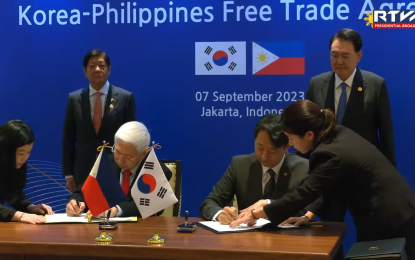
FREE TRADE DEAL. President Ferdinand R. Marcos Jr. (standing left) and South Korean President Yoon Suk Yeol (standing right) witness the signing of the free trade agreement between Trade Secretary Alfredo Pascual (seated left) and South Korean Trade Minister Ahn Duk Geun (seated right) on Thursday (Sept. 7, 2023). The FTA was signed on the occasion of the 24th ASEAN-Korea Summit in Jakarta, Indonesia. (Screenshot from Radio Television Malacañang)
MANILA – The Philippines and South Korea have signed a free trade agreement (FTA) on the sidelines of the 43rd Association of Southeast Asian Nations (ASEAN) Summit and Related Summits in Jakarta, Indonesia.
President Ferdinand R. Marcos Jr. and South Korean President Yoon Suk Yeol witnessed the signing of the FTA between Trade Secretary Alfredo Pascual and South Korean Trade Minister Ahn Duk Geun on the occasion of the 24th ASEAN-Korea Summit on Thursday.
Marcos said the trade agreement would further enhance the vibrant relationship and partnership between the Philippines and South Korea, expressing optimism that it would go beyond the government-to-government partnership to involve private firms and private sector partners.
“The signing of the FTA is certainly a very big step in that regard. It can only be a successful arrangement for both our countries. I look forward to the expansion of the trade agreement between your country and mine,” he told Yoon.
“When I look at the involvement of Korea and the Philippines, I can say that the relationship between our two countries remains vibrant. And I think it is accelerating … I would like to take this opportunity to deepen further that relationship.”
The Philippines and South Korea began their negotiations for the FTA in June 2019 and concluded them in October 2021. They were supposed to sign the agreement in June 2022.
However, they had to do some “legal scrubbing” on the concluded chapter texts of the FTA, including the Trade in Goods, Trade Remedies, Customs Procedures and Trade Facilitation, Rules of Origin, Competition, and Chapters under Legal and Institutional Issues.
The Economic and Technical Cooperation Chapter and Market Access for Goods were the remaining issues they had to resolve to end the FTA talks.
The newly signed FTA is expected to remove tariffs on most products from the two countries, opening the door to rapid growth in bilateral trade.
Yoon said he is eager to elevate the strategic partnership between the Philippines and South Korea.
“And in this regard, I believe that the Korea-Philippines Free Trade Agreement signed later today will set another important milestone in our bilateral relations,” he told Marcos.
Pascual, meanwhile, said the FTA serves as a “clear demonstration of the intent to elevate the current bilateral relations with South Korea to a stronger strategic partnership.”
“The Philippines’ engagement with South Korea is built on trade through market access, economic cooperation, and investments through collaboration in targeted sectors, such as critical minerals and supply chains,” he said.
The FTA is envisioned to help promote the Philippines as a strong market for smart and sustainable investments, ensure its major economic gains with enhanced market access to South Korea, and yield strategic investments in priority sectors and industries.
South Korea is a valued trade and investment partner of the Philippines.
In 2022, it ranked fourth in terms of total bilateral trade, valued at USD15.45 billion, and sixth in total approved investments, valued at USD90.62 million.
Continued support
Yoon also expressed his interest in the supply chain of critical materials, allowing the Philippines to shift to a nuclear power plant.
Marcos thanked Yoon for South Korea’s financial support for development projects in the Philippines, saying he looks forward to learning about the South Korean experience in terms of energy source development.
He also extended his gratitude to the South Korean government for its continued support for the defense and security measures of the Philippines, especially on the South China Sea issues and the modernization of the Armed Forces of the Philippines.
In terms of tourism, Marcos acknowledged that South Koreans remain the top tourists in the Philippines.
Yoon said South Korea is keen on expanding opportunities for overseas Filipino workers through its “employment permit system.”
